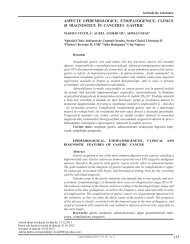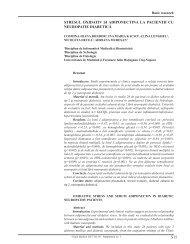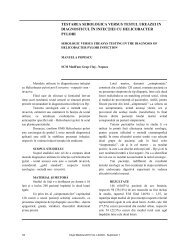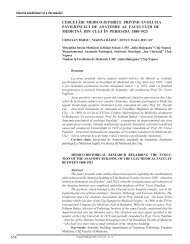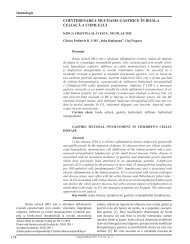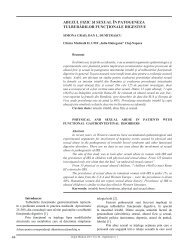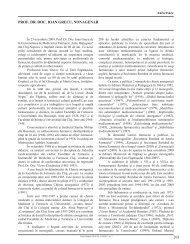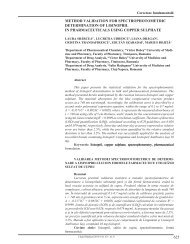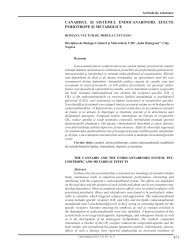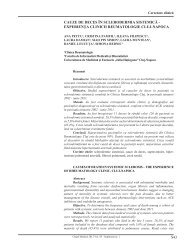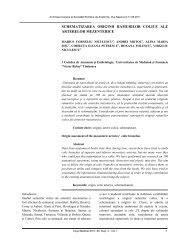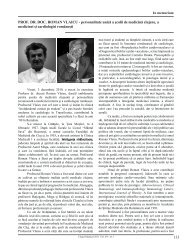RevistÄ de MedicinÄ Åi Farmacie - Clujul Medical - Iuliu HaÅ£ieganu
RevistÄ de MedicinÄ Åi Farmacie - Clujul Medical - Iuliu HaÅ£ieganu
RevistÄ de MedicinÄ Åi Farmacie - Clujul Medical - Iuliu HaÅ£ieganu
You also want an ePaper? Increase the reach of your titles
YUMPU automatically turns print PDFs into web optimized ePapers that Google loves.
Patologie digestivă<br />
Ultrasonography<br />
The movements of stomach, pylorus and duo<strong>de</strong>num<br />
can be observed by ultrasonography after the subject has<br />
ingested a liquid or semiliquid test meal [7,8]. At the same<br />
time the gastric emptying of the test meal can be measured<br />
by calculating the antral cross-sectional area over time.<br />
However such an examination requires a certain experience<br />
and is time-consuming. So, this method is not used in daily<br />
clinical practice.<br />
Pressure recordings<br />
Manometry<br />
Manometry is a technique to measure intraluminal<br />
pressures in the gastrointestinal tract either using waterfilled<br />
catheters or electronic miniature pressure <strong>de</strong>vices<br />
called microtransducers. For infusion manometry [9-11] the<br />
essential elements are a pneumohydraulic pump, pressure<br />
transducers, a polygraph, and manometry catheters (Fig. 3).<br />
The pressure transducers used in this technique are volume<br />
transducers. The displacement of water from the catheter<br />
into the transducer causes movement of the diaphragm in<br />
the pressure transducer. This movement of the diaphragm<br />
is transduced into an electric signal using sophisticated<br />
electronics, and this electrical signal can be shown on<br />
the polygraph. The accuracy of pressure measurements<br />
requires all three elements - infusion pump, pressure<br />
transducer and catheters - to be minimally compliant (i.e.<br />
hardly <strong>de</strong>formable). The usually used pneumohydraulical<br />
pump must be able to <strong>de</strong>liver a constant amount of water in<br />
or<strong>de</strong>r that the flow of the water in the catheter is constant.<br />
The catheters used for si<strong>de</strong>-hole manometry (Fig. 4) are<br />
ma<strong>de</strong> of polyvinyl material to ensure a low compliance.<br />
These open-tip catheters incorporate various lumina, each<br />
of which is connected to a pressure sensor and is perfused<br />
with water (0.2 – 0.3 mL/min).<br />
Fig. 3. Essential elements of infusion manometry (scheme).<br />
Dent [12] <strong>de</strong>veloped in 1976 a sleeve <strong>de</strong>vice (Fig. 5)<br />
that uses a long pressure sensor instead of the point sensor<br />
of the si<strong>de</strong>-hole manometry. A short or long membrane is<br />
used, <strong>de</strong>pending on the sphincter of interest. The sleeve<br />
was <strong>de</strong>signed to overcome the relative motion between for<br />
example the lower esophageal sphincter and the pressure<br />
sensor during respiration as well as swallowing. Therefore<br />
the sleeve allows continuous recording of the sphincter<br />
pressure for long periods without motion artifacts.<br />
Fig. 4. Si<strong>de</strong>-hole polyvinyl catheter for water-perfusion<br />
manometry: this catheter is used for esophageal manometry.<br />
Fig. 5. Dent sleeve (scheme): The sensor consists of a thin silicon<br />
rubber membrane un<strong>de</strong>r which water is perfused. The sensor<br />
measures the highest pressure exerted on the membrane.<br />
Instead of perfused catheters, catheters with<br />
incorporated electronic minitransducers are also used<br />
[13]. These sensors transform the intraluminal pressure<br />
into an electric signal. This makes it unnecessary to have<br />
a system which continuously pumps a strictly controlled<br />
flow of water through the catheter. Thanks to this<br />
technique prolonged (ambulatory) manometric studies can<br />
be performed on outpatients. Manometric studies can be<br />
done in various parts on the gastrointestinal tract. In the<br />
esophagus manometry allows us to assess various motor<br />
disor<strong>de</strong>rs causing dysphagia or non-cardiac chest pain<br />
like diffuse spasms, nutcracker esophagus, achalasia, and<br />
involvement of the esophagus in sclero<strong>de</strong>rma and other<br />
systemic disor<strong>de</strong>rs. It is also done before performing<br />
antireflux surgery. Antroduo<strong>de</strong>nal manometry is performed<br />
only in some tertiary centres as well as jejunal manometry.<br />
Antroduo<strong>de</strong>nal manometry may be helpful in same cases of<br />
gastroparesis; jejunal manometry is essential in diagnosing<br />
chronic intestinal pseudo-obstruction (CIPO) and helps<br />
in differentiating myopathic and neurogenic causes. The<br />
pressure in the bile tract and the sphincter of Oddi<br />
can also be assessed by using infusion or microtransducer<br />
manometry. In the recent years it has been shown that<br />
sphincter of Oddi dyskinesia can be responsible for biliary<br />
316<br />
<strong>Clujul</strong> <strong>Medical</strong> 2009 Vol. LXXXII - nr. 3



